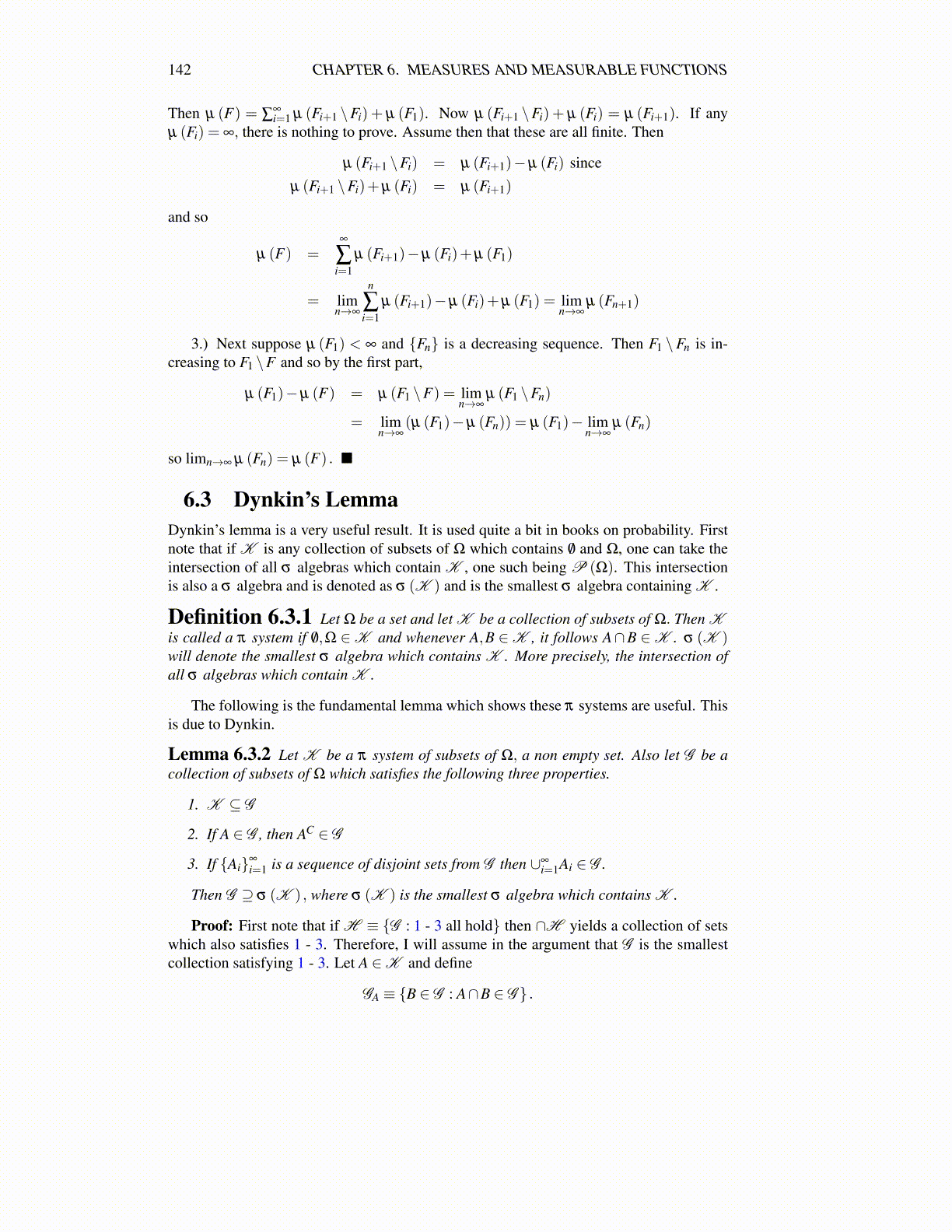
142 CHAPTER 6. MEASURES AND MEASURABLE FUNCTIONS
Then µ (F) = ∑∞i=1 µ (Fi+1 \Fi) + µ (F1). Now µ (Fi+1 \Fi) + µ (Fi) = µ (Fi+1). If any
µ (Fi) = ∞, there is nothing to prove. Assume then that these are all finite. Then
µ (Fi+1 \Fi) = µ (Fi+1)−µ (Fi) sinceµ (Fi+1 \Fi)+µ (Fi) = µ (Fi+1)
and so
µ (F) =∞
∑i=1
µ (Fi+1)−µ (Fi)+µ (F1)
= limn→∞
n
∑i=1
µ (Fi+1)−µ (Fi)+µ (F1) = limn→∞
µ (Fn+1)
3.) Next suppose µ (F1) < ∞ and {Fn} is a decreasing sequence. Then F1 \Fn is in-creasing to F1 \F and so by the first part,
µ (F1)−µ (F) = µ (F1 \F) = limn→∞
µ (F1 \Fn)
= limn→∞
(µ (F1)−µ (Fn)) = µ (F1)− limn→∞
µ (Fn)
so limn→∞ µ (Fn) = µ (F) . ■
6.3 Dynkin’s LemmaDynkin’s lemma is a very useful result. It is used quite a bit in books on probability. Firstnote that if K is any collection of subsets of Ω which contains /0 and Ω, one can take theintersection of all σ algebras which contain K , one such being P (Ω). This intersectionis also a σ algebra and is denoted as σ (K ) and is the smallest σ algebra containing K .
Definition 6.3.1 Let Ω be a set and let K be a collection of subsets of Ω. Then Kis called a π system if /0,Ω ∈K and whenever A,B ∈K , it follows A∩B ∈K . σ (K )will denote the smallest σ algebra which contains K . More precisely, the intersection ofall σ algebras which contain K .
The following is the fundamental lemma which shows these π systems are useful. Thisis due to Dynkin.
Lemma 6.3.2 Let K be a π system of subsets of Ω, a non empty set. Also let G be acollection of subsets of Ω which satisfies the following three properties.
1. K ⊆ G
2. If A ∈ G , then AC ∈ G
3. If {Ai}∞
i=1 is a sequence of disjoint sets from G then ∪∞i=1Ai ∈ G .
Then G ⊇ σ (K ) , where σ (K ) is the smallest σ algebra which contains K .
Proof: First note that if H ≡ {G : 1 - 3 all hold} then ∩H yields a collection of setswhich also satisfies 1 - 3. Therefore, I will assume in the argument that G is the smallestcollection satisfying 1 - 3. Let A ∈K and define
GA ≡ {B ∈ G : A∩B ∈ G } .